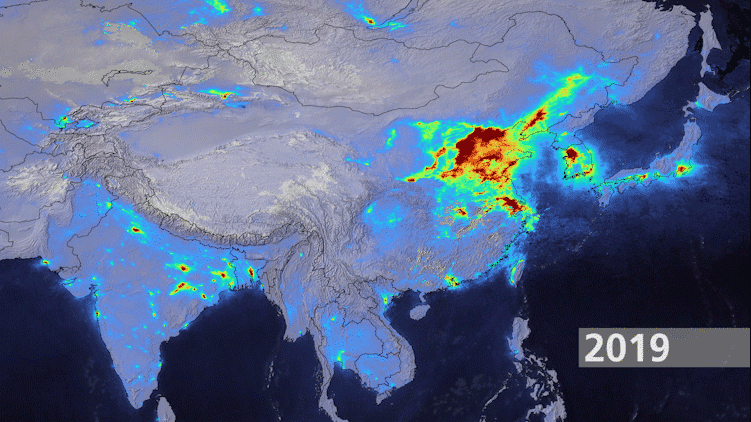COVID-19’s Effect on Air Quality Can Be Seen From Space

THE INSTITUTE Since the early days of the COVID-19 pandemic, scientists and civilians on the ground have observed a sharp improvement in air quality, especially over quarantined regions. A likely explanation was the shutdowns in response to the pandemic, which reduced traffic and power production. But it may not have been the only explanation for the observed improvement. Weather systems can shift away pollution and improve air quality over cities. Now, a new analysis by the European Space Agency (ESA) that combined weather models, pollution measurements from ground stations, and spectral data from satellites supports the idea that the shutdowns were responsible, ruling out weather as a confounding factor.
Pandemic shutdowns have called attention to air quality issues around the world. Photo comparisons of cities before and during quarantine measures show stark reductions in visible smog, while larger regions like North America are reporting lower pollutant concentrations throughout.
 Gif: German Aerospace Center Comparison of nitrogen dioxide emissions over Europe between March and April 2019 and 2020.
Gif: German Aerospace Center Comparison of nitrogen dioxide emissions over Europe between March and April 2019 and 2020. Using the Copernicus Sentinel 5-Precursor (S5P), which can detect the spectral signatures of specific gases, the ESA researchers measured global nitrogen dioxide (NO2) levels that were 20 percent and 75 percent lower during the shutdown period than during the same period in 2019. Locally, the impact of shutdowns on air quality varies widely and likely depends on the different progressions of the pandemic in each region.
But a decrease in measured emissions levels might not mean there has been an actual reduction in emissions. Most NO2-which is emitted primarily by burning biofuels like coal, gas, and diesel-stays relatively close to its source. But this changes as the gas moves upward through the troposphere, the innermost section of Earth's atmosphere. There, the air is in constant motion, and NO2 can be spread across large distances and between atmospheric layers.
Nitrogen dioxide that reaches the sunny upper regions of the troposphere can dissociate to form ozone (O3), another respiratory pollutant at ground level, and nitric oxide (NO), which returns to the ground level as acid rain. According to the World Health Organization, all three molecules-ozone, nitric oxide, and nitrogen dioxide-are linked to early mortality for exposed populations, in addition to worse outcomes for respiratory and cardiovascular illnesses.
Tracking emissions levels by satellite comes with its own challenges. The troposphere, which is home to most weather events, can quickly turn air pollution into soil and ocean pollution-still harmful, but now invisible to satellite spectrometers.
 Gif: German Aerospace Center Comparison of Copernicus Sentinel-5 Precursor satellite recordings of nitrogen dioxide emissions over Asia between 2019 and 2020.
Gif: German Aerospace Center Comparison of Copernicus Sentinel-5 Precursor satellite recordings of nitrogen dioxide emissions over Asia between 2019 and 2020. Air contaminants get easily transported by winds or are washed out by precipitation," says Diego Loyola, lead researcher of the new ESA analysis and an IEEE senior member. His team at the German Aerospace Center Remote Sensing Technology Institute is monitoring the positive impact of the COVID-19 restrictions on the air quality using measurements from the European Copernicus Sentinel-5 Precursor satellite.
Falling rain absorbs the airborne pollutants and drives them to the Earth's surface, falsely deflating the observed concentration of pollutants.
To rule out the possibility that weather might be responsible for some of the emissions decreases over Europe, Loyola and his colleagues at the center built computer models that transformed pre-COVID air pollution satellite data from 2019 using observed European weather patterns from 2020. The resulting model is a weather-adjusted simulation of nitrogen dioxide concentrations in a hypothetical 2020 where the coronavirus pandemic-or at least the shutdowns in response to it-never occurred. With the same weather conditions, the actual 2020 levels were much lower than those in the simulated no-shutdown model, confirming that the drop in manufacturing and transportation was indeed responsible for the cleaner air.
IMPACT ON COVID-19 PATIENTSExposure to air pollution can impact the health outcomes of people who develop the disease, Loyola says. The study showed the positive impact of COVID-19 shutdowns on the air quality," Loyola says. But he notes that the drop in air pollution will be temporary and that long-term emissions are still a health concern.
There's consensus that there's an impact of air pollution on the severity of COVID-19 for individuals," agrees Christa Hasenkopf, codirector of the open-access air quality data platform OpenAQ and an atmospheric scientist.
While the sudden decrease in air pollution may ease the suffering of those infected with the novel coronavirus, Hasenkopf says, the illness is especially harmful on those with the same type of chronic respiratory and cardiovascular conditions that result from long-term exposure to pollution.
The WHO estimates that 90 percent of people worldwide breathe polluted air, with the bulk of pollution affecting lower-income countries. These disparities could point researchers to where resources are most needed, Hasenkopf says.
We're asking, How does air pollution affect folks with COVID-19, and how does that help us prioritize areas that may experience more severe outbreaks?'"
Attention IEEE members: are you part of a team responding to the COVID-19 crisis? We want to hear from you! Wherever you are and whatever you are doing, if you are helping deal with the outbreak in some way, let us know. Send us accounts of anywhere from 200 to 800 words, or simply give us a rough idea of what you are doing and your contact information. Write to: k.pretz@ieee.org
< Back to IEEE COVID-19 Resources